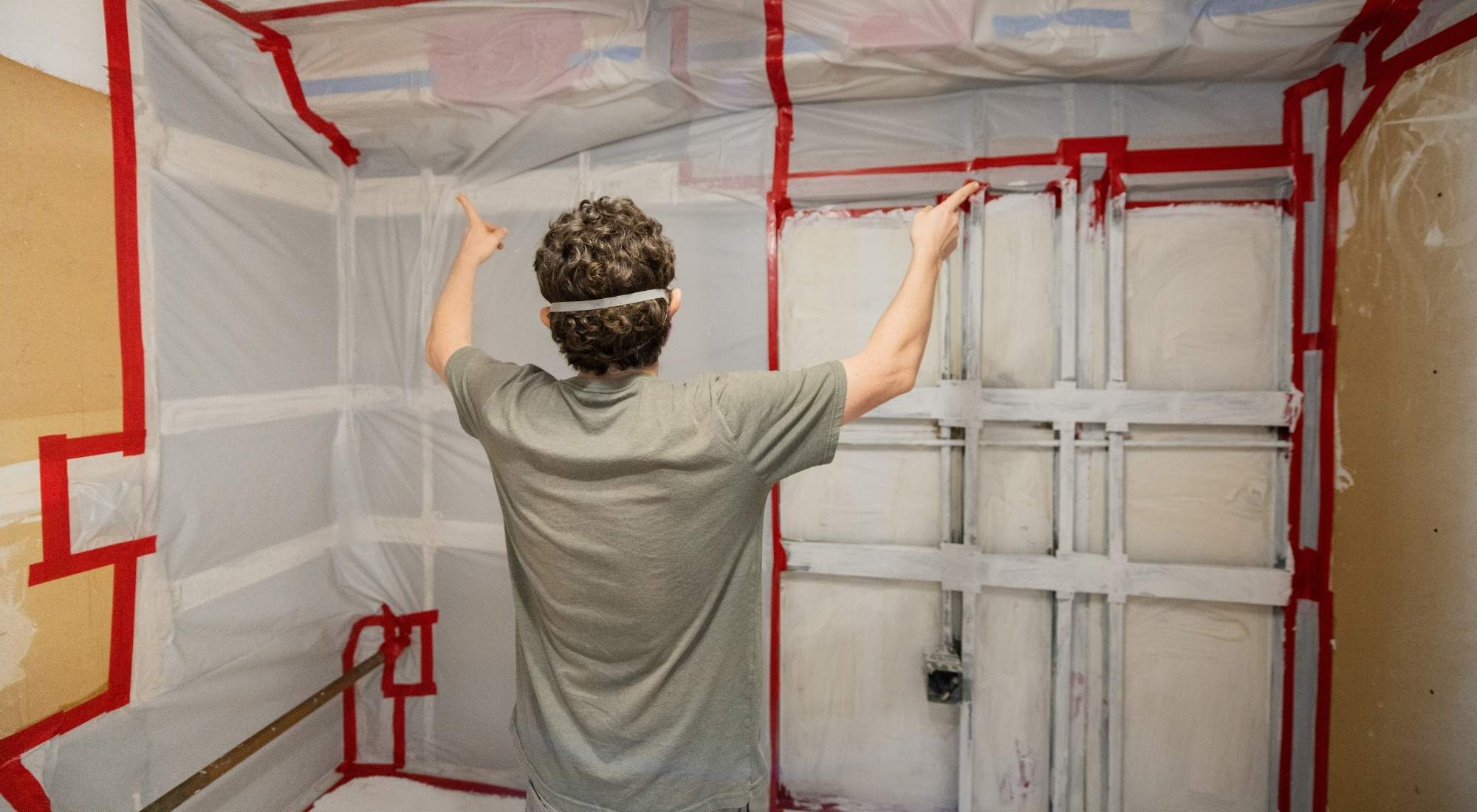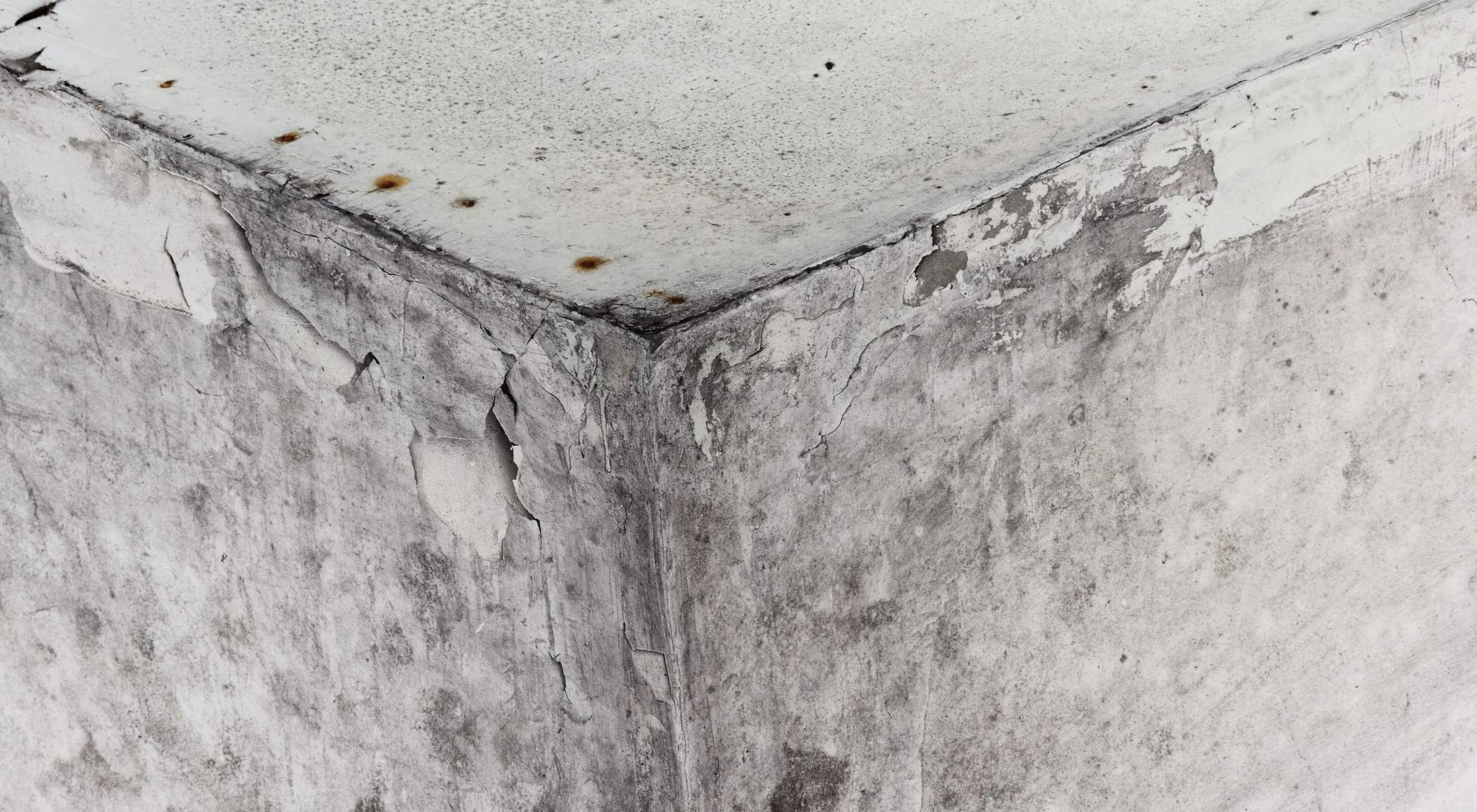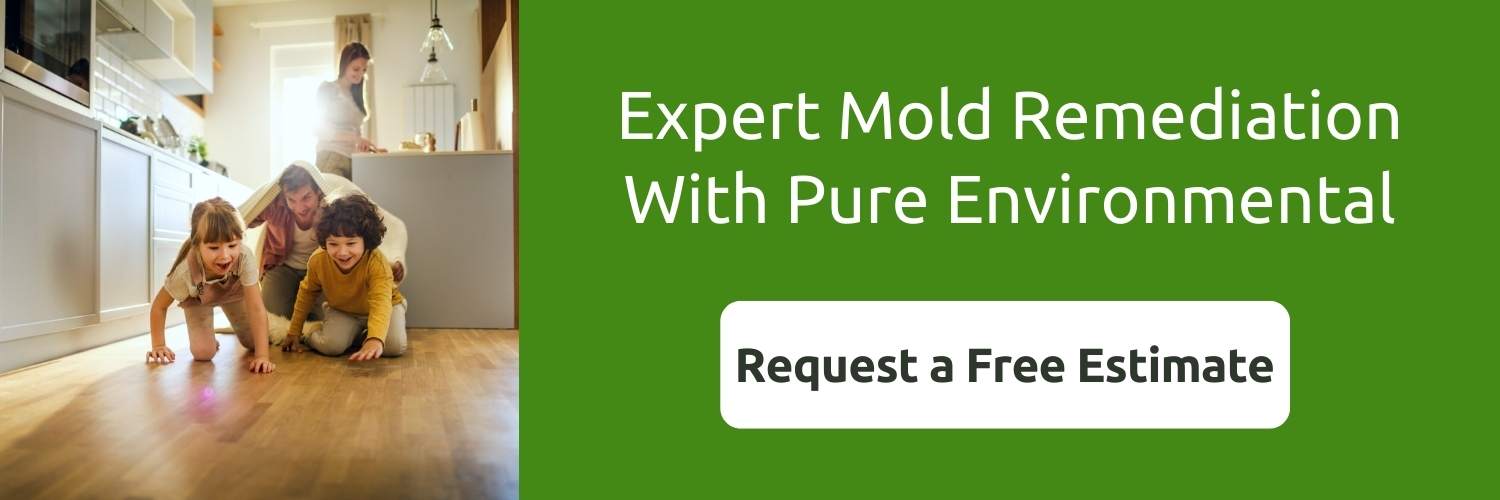You have a cough you can’t shake. There’s a musty odor in the air you can’t put your finger on. Or maybe you’ve seen the dreaded tell-tale signs of mold growth.
It’s time to call in the experts for mold remediation.
But what exactly is mold remediation? In this article, we will break down the mold remediation process and answer questions we hear time and time again with clients.
Table of Contents
- What Is Mold Remediation?
- Is There a Difference Between Mold Removal and Remediation?
- When Is Mold Remediation Necessary?
- What Does Mold Remediation Include?
- 9 Steps That May Be Required Throughout Your Mold Remediation Process
- Mold Remediation FAQs
- Trust the Experts at Pure Environmental for Complete Mold Remediation
What Is Mold Remediation?
The word “mold” is enough to strike fear into any homeowner. However, microscopic mold spores exist in almost every environment, indoors or outdoors.
Mold remediation involves eliminating harmful mold growth — which is typically the kind of growth you can see and smell.

Is There a Difference Between Mold Removal and Remediation?
You may have heard about mold removal services before. Mold removal involves attempting to eradicate or clean away all mold, whether it is harmful or unharmful.
However, due to its natural occurrence, it is impossible to completely eliminate all mold spores from an environment, whether we are talking about your backyard or basement.
Mold remediation is a more realistic approach to ensuring your home is free of harmful mold spores.
When Is Mold Remediation Necessary?
Has someone in your home developed mold allergy symptoms? Is there a lingering, musty odor in your home that you can’t pinpoint? Do you have mold growth in your home that you can physically see with your own eyes?
If any of these scenarios apply to you, it is highly advised to seek mold remediation services.
Routinely inspecting your home, especially darker, cooler areas like your basement, crawl space, attic and garage can help you identify any mold growth that may need to be professionally addressed.
What Does Mold Remediation Include?
Mold remediation can look different based on factors like:
- The location of the mold growth
- The type of structures mold is growing on
- The level of infestation
- The type of mold growing
- And more
Typically, this process involves:
- Mold testing
- Containment
- Sanitization
- Removal
- Cleaning
- And more

9 Steps That May Be Required Throughout Your Mold Remediation Process
Let’s go over some fundamental steps of mold remediation below.
#1: Inspection and Assessment
All mold remediation begins with inspecting and assessing the mold growth.
This step is critical in identifying what the following steps for mold remediation should look like, as the process can vary depending on the type of mold and the severity of mold growth.
#2: Containment
When disturbed or agitated, mold produces spores. The last thing you want during a mold remediation job is to have workers kicking up mold spores that may be distributed throughout the rest of your home as a result.
For this reason, affected areas need to be isolated and contained before the removal and cleaning process is started.
#3: Negative Air
Outside of the contained area, a negative air machine may be used as a preventative measure to ensure any airborne mold spores that potentially escaped the contained area are removed from the air. This is a key component to any mold remediation due to mold related health issues.
#4: Source Removal
During this process, it’s important to identify what materials can be cleaned and what materials need to be removed. The ultimate goal is to remove as much mold as possible in this stage.
In some cases, materials are so heavily affected that they cannot be cleaned. For example, mold growth cannot always be cleaned from drywall. The best measure, in this case, is to cut out and remove the affected drywall.
Materials that require removal are typically porous or made with organic materials, such as:
- Drywall
- Particle boards
- Glues
- Paper
- Cellulose-based items
- And more
Other materials like concrete, wood framing, or plywood that haven’t rotted can be easily cleaned.
#5: Moldicide
At this point, EPA-registered antimicrobial is applied to areas that can be cleaned to try to kill the roots of the mold as it grows into the type of materials being treated.
#6: Stain Removal
Each mold remediation company tends to perform this step differently. Typically, stain removal is done two different ways:
- A mold stain removal chemical is applied to treated areas to remove staining.
- A sealant is applied to “seal” and conceal mold strains.
Mold stain removal isn’t just about aesthetics — it’s important to remove or conceal old mold stains so it is easy to distinguish any potential new mold growth in the future.
Mold stain removal can also help prevent future mold growth from occurring.
#7: HEPA Vacuuming
Once the area has been treated, all surfaces within the containment zone are cleaned. A vacuum with a HEPA filter is used to capture any fine mold particles that may have been disrupted within the containment area.
#8: Containment Area Clean-Up
One final cleaning treatment is administered for mold clearance.
At Pure Environmental, we may administer a PurAyr™ treatment, which is a powerful tool for air and surface decontamination. This treatment ensures good air quality and that any potential remaining mold spores are neutralized.
#9: Post-Remediation Testing
Depending on the scope of the project and client, post-remediation testing may be recommended. In this case, a third-party hygienist performs testing and collects air samples to ensure good air quality has been fully achieved through remediation.

Mold Remediation FAQs
Can Mold Growth Come Back After Remediation?
Mold remediation does not eliminate the possibility of future mold growth.
Mold likes to grow between 60-80 degrees. It simply needs moisture, an organic food source, and mold spores. If these conditions are met, mold will grow.
Ultimately, a damp or high-humidity environment can be a potential breeding ground for mold. The best way to avoid regrowth after mold remediation is to fix the source of the problem, whether it’s a pesky leak or a missing vapor barrier in your crawl space.
Can You DIY Mold Remediation?
Perhaps you see a small area of mold growth in your basement and think, “I can just clean this myself, right?”
There can be potentially dangerous mold growth hiding behind that harmless-looking mold stain. It is best to get a professional inspection to get the full scope of what you may be potentially dealing with before attempting to clean up mold growth by yourself.
Without proper containment, attempting to remove mold by yourself can trigger mold spores to become airborne and potentially latch onto other surfaces in your home.
When Should You Call a Mold Remediation Specialist?
If you see mold growth — or smell a musty odor in your home — call a mold remediation specialist. They can help you determine the source and severity of mold growth in your home and help you get rid of it.
Trust the Experts at Pure Environmental for Complete Mold Remediation
Operating in the Pacific Northwest since 2010, our team is no stranger to mold remediation. From moldy basements to crawl spaces to attics — we’ve seen and done it all.
If you’re dealing with a mold problem, leave it to our highly trained team to efficiently and safely remove harmful mold from your home. Contact us today to get a free estimate on mold remediation services for your home.
Recent posts
- Clearing the Air: How To Clean Walls From Cigarette Smoke
- Deodorizing Your Living Space: How To Get Rid of a Musty Smell in Your House
- How Do You Get Rid of Mold in Your Attic? Tips from the Professionals
- Structural Damage to a House: Signs of Damage and Determining What Can and Cannot Be Fixed
- What To Do When Your Pipes Freeze: Steps To Take To Minimize Damage From Frozen or Ruptured Pipes
Recent Posts
- Clearing the Air: How To Clean Walls From Cigarette Smoke
- Deodorizing Your Living Space: How To Get Rid of a Musty Smell in Your House
- How Do You Get Rid of Mold in Your Attic? Tips from the Professionals
- Structural Damage to a House: Signs of Damage and Determining What Can and Cannot Be Fixed
- What To Do When Your Pipes Freeze: Steps To Take To Minimize Damage From Frozen or Ruptured Pipes
